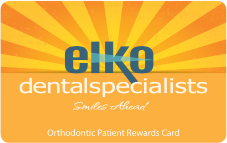Invisalign for Teens
Invisalign® is a great alternative to braces for teens who would prefer to straighten their smile without braces. With Invisalign, your teen can play in the school band and even play sports without changing their schedule or their approach. Invisalign uses a series of invisible, removable and comfortable aligners that are virtually invisible. So teens can concentrate on all the challenges that come with that stage of life without worrying about their smiles. Invisalign aligners are made with 3-D computer imaging technology and have revolutionized the way we treat teeth. Each aligner has the perfect amount of movement programmed in. Teens wear their aligners 24/7, taking them out only to eat, brush and floss. It's easy to get started with Invisalign. At Elko Orthodontics, we take a digital scan of your teeth, capturing (in great detail) your dental anatomy. This scan is painless and fast. uses the scan to determine your prescription and then works with Invisalign to create your virtual computerized treatment. Once approved by the virtual treatment plan is used to create all the aligners needed to improve the smile.Invisalign
Looking for a more discreet orthodontic solution? Invisalign might be the perfect way for you to make a beautiful healthy smile a reality. Invisalign uses a series of invisible, removable and comfortable aligners that no one can tell you’re wearing. So you can be confident that people will see your smile and not your orthodontic treatment. Invisalign aligners are made with 3-D computer imaging technology and has been proven effective. More than 70% of orthodontists in the US and Canada are certified to treat with Invisalign. Invisalign represents a major advancement in orthodontics, making treatment more appealing to anyone who wants the benefits of a great smile. And it's easy to get started with Invisalign. At Elko Orthodontics, we take a digital scan of your teeth, capturing in great detail your dental anatomy. This scan is painless and fast. We send that along with your photographs and your treatment plan to the manufacturers of Invisalign who create your virtual computerized treatment. That's when a series of aligners is created and shipped to our office. Each set of aligners is then worn 22 hours a day, for 1-2 weeks, according to Dr. instructions, before moving to the next set in the series. The aligners can be removed for eating, drinking, brushing and flossing. They're comfortable to wear, and you'll love how they feel and how your teeth look when we're done.-
Who Needs Orthodontic Treatment?
-
When Should My Child Be Screened?
-
What are Advantages of Early Treatment?
-
What are the Types of Braces?
-
How does orthodontic treatment help?
-
How do I know if I need braces?
-
When should I get orthodontic treatment?
-
Do I really need braces? Won’t my teeth get straighter over time?
-
What is Two-Phase Treatment?
-
Can I get braces as an adult?
-
How long does treatment last?
-
Can I still play sports with braces?
-
Do I still need to see my general dentist during treatment?
-
Do I have to avoid certain foods?
-
What happens once I get my braces off?
-
What to Do in Case of an Orthodontic Emergency?
-
Sore Teeth?
-
Wire Irritation?
-
Loose Bracket or Bands?
-
Lost Separator?
An underbite occurs when the lower jaw extends too far forward, causing the bottom teeth to sit in front of the top upper teeth.
Once of the most common problems we see at our office are spacing issues between teeth. This is what the majority of orthodontic patients seek to resolve. Spacing can be caused by a number of factors including missing teeth, or they could simply be a cosmetic issue that occurred as your adult teeth grew in.
This problem occurs when the upper teeth extend too far forward, while the lower teeth are not extending far enough.
Crowding is characterized by insufficient room for your teeth to come in. Oftentimes you’ll see teeth crossed or overlapping slightly. This can generally be fixed with expansion, and in many cases we can avoid removing any teeth.
Those who are experiencing a crossbite may also be suffering from misaligned jaw growth and tooth stratification. A crossbite is characterized by the upper teeth sitting inside the lower teeth.
Similar to a protrusion, an overbite is characterized by the upper front teeth extending out and over the lower front teeth. This often causes the lower teeth to bite into the roof of your mouth, causing bleeding and pain.
An openbite is caused by the upper and lower front teeth not overlapping. This impacts proper chewing and can often be caused early on by habits like thumb sucking in children.
One characteristic Dr. Gardner will search for is proper back bite matching. When the dental midlines do not match, the back bite is not fitting properly. This can impact everything from jaw to dental function.





